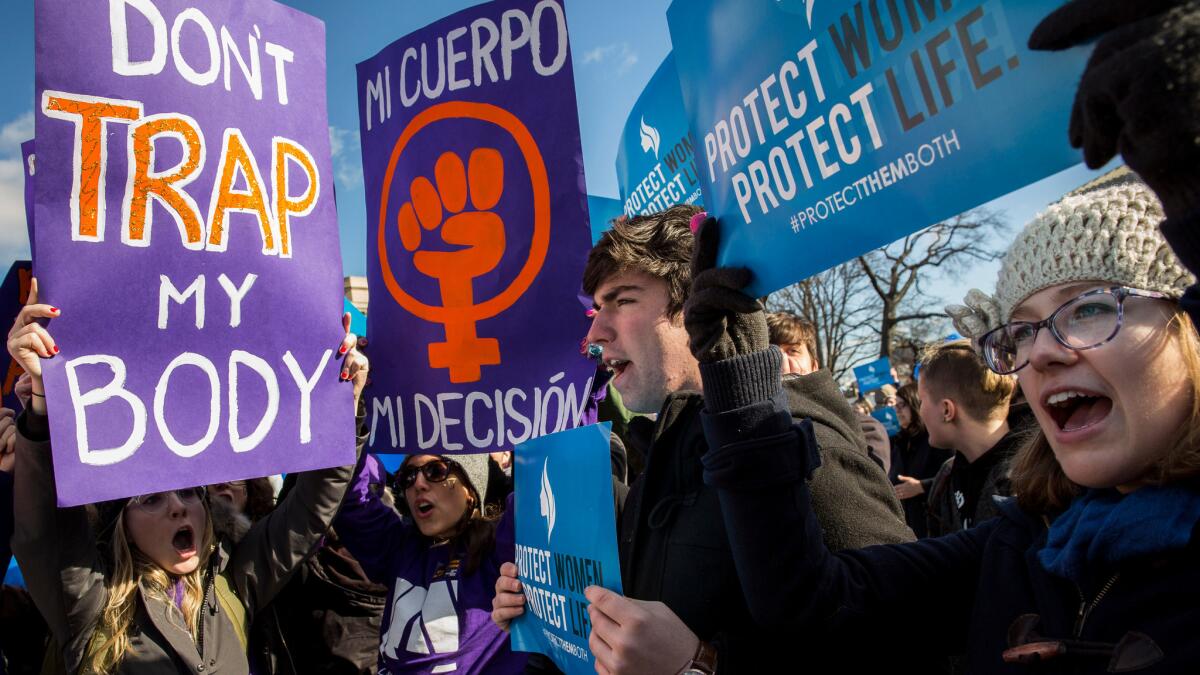A look at the abortion case before the Supreme Court, by the numbers

- Share via
Reporting from Houston — This month, the U.S. Supreme Court is expected to rule in the first landmark abortion case in decades, Whole Woman’s Health vs. Hellerstedt. The ruling could have an immediate effect not only in Texas, but in more than half a dozen other states that have recently passed laws restricting access to abortion clinics.
In 2013, Texas passed a law that included two key provisions requiring abortion clinics to upgrade into ambulatory surgical centers and abortion doctors to have hospital admitting privileges. It’s that law that abortion provider Whole Woman’s Health sued to block. (It operates three clinics and a surgical center in Texas.)
It’s not clear what the impact of the court’s decision in the Texas case will be nationwide: 22 other states require abortion clinics to meet standards similar to ambulatory surgical centers; four require admitting privileges, according to the Guttmacher Institute, a nonprofit that supports abortion rights. If the high court sides with Texas, or sends the case back to the U.S. 5th Circuit Court of Appeals, similar laws stayed by the courts could be enforced in Kansas, Michigan and Wisconsin.
A look at some notable numbers related to the case:
19: Total number of abortion clinics in Texas
Before the law passed, Texas had 41 abortion providers. Now they have 19. The courts have exempted two border clinics from some of the requirements, one in El Paso and another in McAllen. The exemptions were granted because of the distance women would have to travel to the nearest clinic. The closest clinic to the Whole Woman’s Health facility in McAllen is 250 miles north in San Antonio.
If the law is allowed to take full effect, 10 clinics would close, including the McAllen clinic, officials said this week. The remaining nine clinics would all be in major cities – Austin, Dallas, Houston, Fort Worth and San Antonio – far from women on the border and in rural West Texas.
85 miles: The average distance Texas women now travel one-way to reach a clinic
Texas women have been traveling farther for abortions, some to clinics in Louisiana, New Mexico, Oklahoma and Kansas.
The national average is 30 miles one-way, and women whose local clinics stayed open traveled less than that, an average of 22 miles, according to a recent study by the Texas Policy Evaluation Project.
If the high court upholds the Texas law, women will end up spending more to travel farther, according to Nancy Northup, president and chief executive of the Center for Reproductive Rights.
“The few remaining providers will not be able to meet the demand for abortion services,” Northup said during a briefing Tuesday.
See the most-read stories this hour >>
3 weeks: The average wait for an appointment at Whole Woman’s Health in Fort Worth
After the Texas law passed, the number of clinics in the Dallas-Fort Worth area – which serve women from as far away as West Texas and Oklahoma - dropped from 10 to four, and wait times increased.
“We have a patient who jumped into her RV and drove all the way to San Antonio because the wait was too long in the Dallas area,” said Amy Hagstrom Miller, president and chief executive of Whole Woman’s Health and lead plaintiff in the case.
Another woman drove from Fort Worth to Austin in an RV with her husband and children, Miller said, because “it was the only way they could afford lodging and transportation.”
One of the clinics that closed after the law passed was in Lubbock, about 350 miles west of Dallas. An unemployed, uninsured single mother of three from Lubbock called the Whole Woman’s Health clinic in Fort Worth half a dozen times during her pregnancy trying to raise enough money to pay for her travel and the procedure. Texas bans abortions at 20 weeks of pregnancy.
“By the time she was able to have an ultrasound, she was too far along to have an abortion in the state of Texas,” Miller said.
The Texas law’s restrictions had applied to medication as well as surgical abortions, which aggravated wait times. Women who chose abortion-inducing medication were required to wait, then return four times, seeing the same doctor each time, based on the U.S. Food and Drug Administration’s guidelines.
The proportion of women choosing the medication, mifepristone, dropped from between 40% and 50% to about 2% after the law passed, Miller said.
In March, the FDA changed its guidelines, allowing women to receive the drug further into pregnancy and in fewer visits. Now the number of women choosing medication is back to what it was before the law passed, Miller said.
18 months to four years: The time it takes to build an ambulatory surgical center
There are no plans to build new abortion clinics that meet the Texas law’s ambulatory surgical center requirements, said Stephanie Toti, senior attorney at the Center for Reproductive Rights, who argued the case before the Supreme Court on behalf of Texas abortion providers.
If the Supreme Court rules in favor of Whole Woman’s Health, it and other providers could reopen some of the 22 clinics that closed after the Texas law passed, Toti said. But it’s unclear how many or how long it would take.
Clinics that remained open after the law passed but stopped providing abortion services would still have to reapply for two-year abortion clinic licenses and be inspected, which can take up to a year, she said.
“We can’t reopen clinics overnight,” Miller said, noting that providers have had to sell buildings, give up leases, lay off staff and allow doctors to take other jobs.
ALSO
Gruesome hot spring death highlights problem of tourists breaking the rules at Yellowstone
China will not build L.A.-to-Vegas rail line — U.S. company calls the deal off
Former Stanford swimmer blames ‘party culture and risk-taking behavior’ for sex assault
More to Read
Sign up for Essential California
The most important California stories and recommendations in your inbox every morning.
You may occasionally receive promotional content from the Los Angeles Times.











